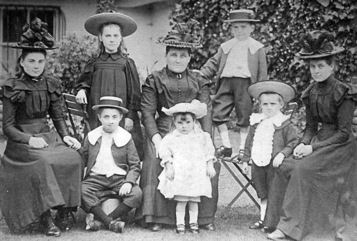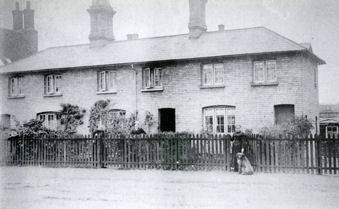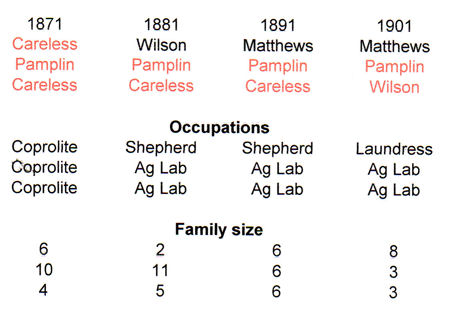This interpretation of the census returns for Trumpington High Street is based on a presentation given at the meeting titled Along the High Street , 26 March 2009. It is one of a group of pages about the High Street .
I have applied my experience as a researcher into family history to look at some of the ordinary families who lived in the High Street. I have used the census returns for Trumpington to try to find who lived where and a bit about them.
Walter and Millie Stearn, c. 1900. Photo: Josephine Kitson.
To put this into context, a little about the censuses that are available for research. The Government has organised a census every 10 years since 1801, except for 1941. The first four censuses have no personal details recorded; only the statistical information remains for the vast majority of the country. The latest census details to be made available to the public are for 1911, which have been released in 2009. However, it is expensive to consult the 1911 census, so the last one that I have looked at is the 1901. Each of the censuses from 1841 to 1901 is now available on the internet, and that is where I have obtained the information for Trumpington. Unfortunately, it is not possible to reproduce examples from the censuses in this report, but I hope you will be able to appreciate the type of information they convey.
When you look at the early Trumpington returns, initially you are often left wondering which bit of the village you are in, as road names are few and far between. Even if the road names are there, then until 1901 there are no house numbers, so in a long road like London Road which was what we now know as High Street was called, it is difficult to work out just where you are. Even as late as 1939, the houses in the High Street were not numbered. You might expect the census enumerator just to walk up one side of the road and then down the other, but in many cases, once you work out who is where, it becomes obvious that he did it in small sections, moving from one side of the road to the other, sometimes moving north to south and sometimes the other way. That all gets jumbled up on the census returns.
If you are lucky, you can recognise where you are because of the people listed, such as the Pemberton family. When it comes to London Road, High Street, Cambridge Road, the names used for the main road through the village, it is a bit less obvious. Occasionally you get the name of a pub, or that of a larger house, to help you locate the smaller houses. I am going to focus on two groups of such houses, where ordinary people lived.
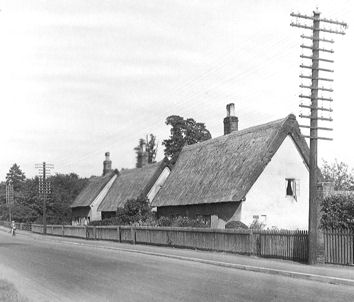
Thatched cottages in the High Street, between Wingate Way and Alpha Terrace. Photo: Josephine Kitson. Reproduced in Trumpington Past & Present , p. 66.
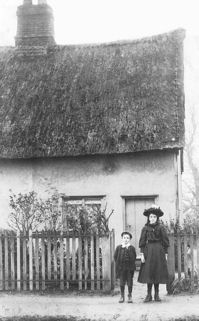
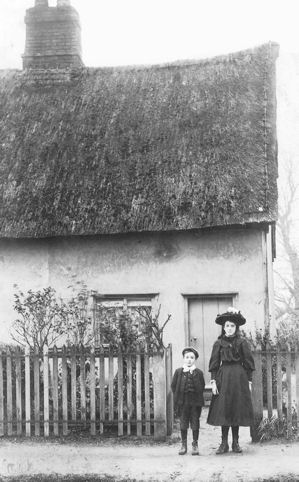
Walter and Millie Stearn, c. 1900. Photo: Josephine Kitson. Reproduced in Trumpington Past & Present , p. 66.
The 1901 census has a page about Cambridge Road, including the names of three of the bigger houses to help us (Cromwell House, Goldeslie and Quy Villa). We can pinpoint Cromwell House, and a bit of reading from Trumpington Past and Present tells us that Goldieslie was the former name of Gazeley House, so we know exactly where we are.
But what about the other, unnamed, houses? One entry details the members of the Stearn family. We have James Stearn, age 30, born in Trumpington, a teamster on a farm, that’s a man who worked with a team of horses. With him are his wife Amelia, also aged 30, and two children: Amelia, age 4, and Walter, 4 months, both born in Trumpington. They are living on the east side of what we would now call the High Street, south of Cromwell House.
In Trumpington Past and Present , there is a photograph of Millie (Amelia) and Walter Stearn outside their cottage, taken about 1900, and another photograph of three pairs of semi-detatched cottages. These were demolished before I moved here in 1980, but according to my neighbour were a very pretty feature of the High Street. The northernmost one is where the Stearns lived.
The other families listed with the Stearns must have been in this same row of houses. Table 1 has the surnames of the families who lived in these six cottages between 1851 and 1901, including the Stearns. The ones in red are those where the head of the household was born in Trumpington – as you can see, a lot of families were very faithful to the village. One of the cottages was occupied by the Kefford family for all these 50 years, indeed the 1939 Spaldings Street Directory shows that there was still a Kefford living in the same house. The table also shows the occupation of the heads of household, which are predominantly working class, with jobs connected with the land. The table shows that those small cottages contained a lot of people. Family sizes grew and then reduced, of course, but in 1871 and 1881 the middle pair of little cottages had 16 people living in it. Not what we would expect today – if it was, we certainly would not be looking at the need for the modern expansion of Trumpington. So that’s one little set of ordinary families and a bit of what we can discover about them and their homes.
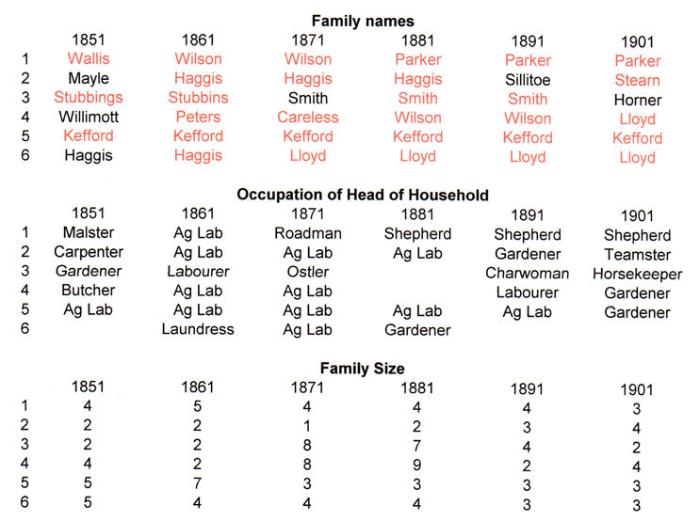
Table 1. Family living in the former cottages on the east side of the High Street. Source: Census returns (Howard Slatter).
Mrs Matthews and her family, Elizabeth, Agnes, Charles, Ellen, William, Bertie and Sarah, c. 1900. Photograph: reproduced in Trumpington in Old Picture Postcards , 63.
Another family that we know a bit about were living in a house on the west side of the road in 1891 and 1901 (now numbered 42 High Street). Mrs Matthews was a widow by 1901, bringing up seven children on her own. The terrace of houses (now numbered 42, 44 and 46 High Street) must have been built between 1861 and 1871, as you can track then back through the censuses until there is no sign of them in 1861.
Table 2 includes information for the three houses, with number 42 at the top of the list. Notice similar occupations here, except that in 1871, typically of much of Trumpington, all three fathers were digging coprolites rather than working in agriculture. Again, some big families in small houses.
When looking at the census return for the three houses in 1871, shortly after they were built, I was surprised to find that I had two personal connections with the families. Firstly, 11 year old John William Pamplin was the original owner and builder of the house where I now live (82 Shelford Road). Secondly, the heads of the two Careless families, Richard and William, were brothers. Their grandfather, another William, moved to Trumpington from Little Shelford in about 1790. He had many descendants, and among them are Percy Reed (P.O. Reed) the Cambridge hairdresser and former Mayor of Cambridge, and also two of my grandchildren.
That gives a flavour of what you can discover from the census. I’ve really only just scratched the surface here, and there is the scope for much more research into who lived where and when in Trumpington. the High Street, south of Cromwell House.
Mrs Matthews outside her house in the High Street (now 42 High Street). Photograph: reproduced in Trumpington in Old Picture Postcards , 61.
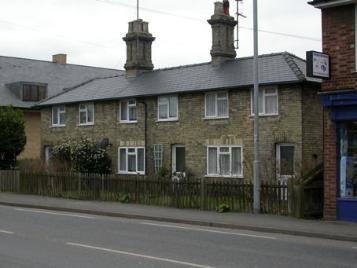
42, 44 and 46 High Street in 2009. Photo: Howard Slatter.
Table 2. Families living in 42, 44 and 46 High Street. Source: Census returns (Howard Slatter).
